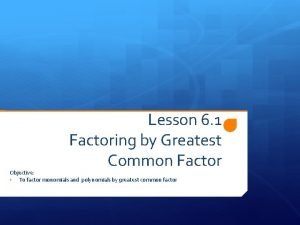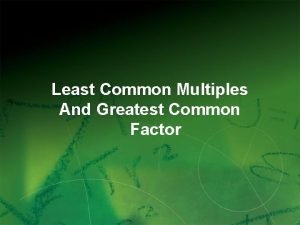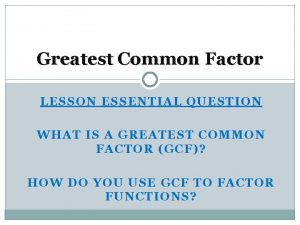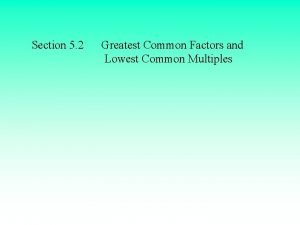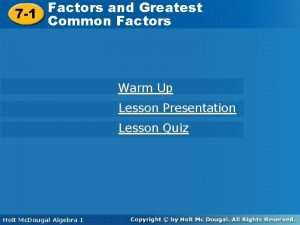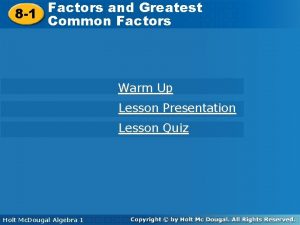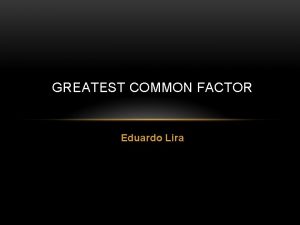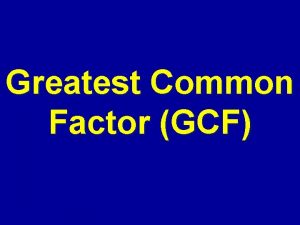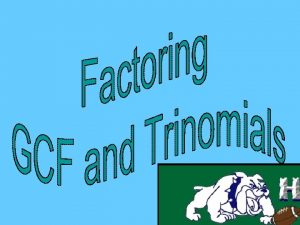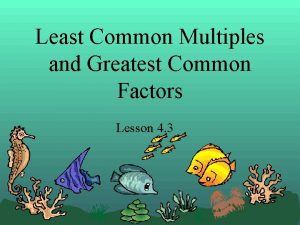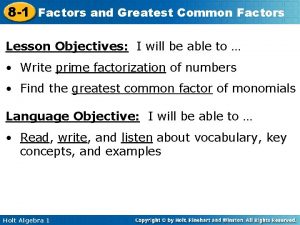Lesson 9 1 Factors and Greatest Common Factors














- Slides: 14

Lesson 9 -1 Factors and Greatest Common Factors

Objectives • Find prime factorizations of integers and monomials • Find the Greatest Common Factor (GCF) of integers and monomials

Vocabulary • Prime number – a whole number, greater than 1, whose only factors are 1 and itself • Composite number – a whole number, greater than 1, that has more than two factors • Prime factorization - a whole number expressed as a product of factors that are all prime numbers • Factored form – when a monomial is expressed as a product of prime numbers and variables and no variable has an exponent greater than 1. • Greatest common factor (GCF) – the product of the prime factors common two or more integers

Four Step Problem Solving Plan • Step 1: Explore the Problem – Identify what information is given (the facts) – Identify what you are asked to find (the question) • Step 2: Plan the Solution – Find an equation the represents the problem – Let a variable represent what you are looking for • Step 3: Solve the Problem – Plug into your equation and solve for the variable • Step 4: Examine the Solution – Does your answer make sense? – Does it fit the facts in the problem?

Prime and Composite Numbers • Prime Number – A whole number, greater than 1, whose only factors are 1 and itself – Examples: 2, 3, 5, 7, 11, 13, 17, 19, 23 • Composite Number – A whole number, greater than 1, that has more than two factors – Examples: 4, 6, 8, 9, 10, 12, 14, 15, 16, 18, 20, 21, 22

Greatest Common Factor • The greatest common factor (GCF) of two or more integers is the product of the prime factors common to the integers • The GCF of two or more monomials is the product of their common factors when each monomial is in factored form • If two or more integers or monomials have a GCF of 1, then the integers or monomials are said to be relatively prime

Example 1 A. Factor 22. Then classify it as prime or composite. To find the factors of 22, list all pairs of whole numbers whose product is 22. Answer: Since 22 has more than two factors, it is a composite number. The factors of 22, in increasing order, are 1, 2, 11, and 22. B. Factor 31. Then classify it as prime or composite. The only whole numbers that can be multiplied together to get 31 are 1 and 31. Answer: The factors of 31 are 1 and 31. Since the only factors of 31 are 1 and itself, 31 is a prime number.

Example 2 Find the prime factorization of 84. Method 1 The least prime factor of 84 is 2. The least prime factor of 42 is 2. The least prime factor of 21 is 3. All of the factors in the last row are prime. Method 2 Use a factor tree. 84 21 3 4 7 2 2 and All of the factors in the last branch of the factor tree are prime. Answer: Thus, the prime factorization of 84 is or

Example 3 Find the prime factorization of – 132. Express – 132 as – 1 times 132. / / Answer: The prime factorization of – 132 is or

Example 4 A. Factor Answer: B. Factor completely. in factored form is completely. Express – 26 as – 1 times 26. Answer: in factored form is

Example 5 A. Find the GCF of 12 and 18. Factor each number. Circle the common prime factors. The integers 12 and 18 have one 2 and one 3 as common prime factors. The product of these common prime factors, 2 3 or 6, is the GCF. Answer: The GCF of 12 and 18 is 6. B. Find the GCF of . Factor each number. Circle the common prime factors. Answer: The GCF of and is .

Example 6 Crafts Rene has crocheted 32 squares for an afghan. Each square is 1 foot square. She is not sure how she will arrange the squares but does know it will be rectangular and have a ribbon trim. What is the maximum amount of ribbon she might need to finish an afghan? Find the factors of 32 and draw rectangles with each length and width. Then find each perimeter. The factors of 32 are 1, 2, 4, 8, 16, 32.

Example 6 cont The greatest perimeter is 66 feet. The afghan with this perimeter has a length of 32 feet and a width of 1 foot. Answer: The maximum amount of ribbon Rene will need is 66 feet.

Summary & Homework • Summary: – The greatest common factor (GCF) of two or more monomials is the product of their common prime factors • Homework: – pg. 477 20 -58 even
 Greatest common factor of monomials
Greatest common factor of monomials Factors of 7
Factors of 7 Common factors of 8
Common factors of 8 Factors to 18
Factors to 18 Lcm of 4 8 and 16
Lcm of 4 8 and 16 Lesson 1 factoring using the greatest common factor
Lesson 1 factoring using the greatest common factor Lesson 2-1 greatest common factor
Lesson 2-1 greatest common factor Lesson 8-2 factoring by gcf
Lesson 8-2 factoring by gcf Factors of 42
Factors of 42 56 prime factorization
56 prime factorization Highest common factors and lowest common multiples
Highest common factors and lowest common multiples Multiples of 9 and 21
Multiples of 9 and 21 Greatest common factor of 56 and 35
Greatest common factor of 56 and 35 Perfect squares between 100 and 200
Perfect squares between 100 and 200 Common factor definition
Common factor definition





